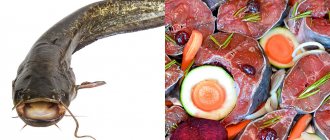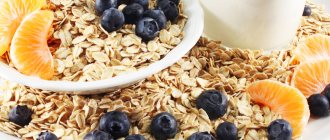India
Indian cuisine is famous for its various spices. They help give any dish a unique taste and have a beneficial effect on the human body. The most commonly used ingredients by Indian cooks are turmeric, chili, ginger, mint, cardamom and cloves. Adding these spices to everyday dishes perfectly protects the body from inflammatory processes and cancer.
LiveInternetLiveInternet
Quote from Maniola_jurtina's message
Read in full In your quotation book or community!
The American “guru” of healthy eating Harley Pasternak has published a book in which he explores the usefulness of the national cuisines of the world. The author found the countries with the lowest obesity rates
Obesity rates were calculated using the percentage of the population who were obese and had the highest life expectancy. After this, the nutritionist identified the nutritional features that made it possible to achieve such results. At the same time, Pasternak stipulates that the health of the nation, of course, does not necessarily depend only on food habits; but it won’t hurt anyone to adopt some useful traditions. As they say - one step at a time.
Japan
Obesity rate: 1.5%.
Average life expectancy: 82 years
What do we associate Japanese cuisine with? First of all, probably with rice. But the secret of the health of this nation does not lie in him. In addition to the rolls and sushi we know, the Japanese consume a huge amount of vegetables, especially rich in vitamins and minerals - zucchini, cucumbers, cabbage and broccoli. The main source of protein for them is fish and soy products, that is, such a menu does not contain harmful cholesterol at all, and carbohydrates are supplied to the body by traditional buckwheat noodles (not wheat noodles - like ours), in which the carbohydrates are special, slow, that is, they are gradually processed into energy and are not stored as extra pounds.
On a note:
For a Japanese, it goes without saying that you don’t eat to your heart’s content, but in such a way as to leave you a little hungry. And science backs up the usefulness of this custom: it takes about 20 minutes for the brain to realize that you're full, so if you wait a little after lunch, you won't feel like eating anymore.
Singapore
Obesity rate: 1.8%.
Average life expectancy: 82 years.
But here rice is truly the king of the table. Singaporeans eat it for breakfast, lunch and dinner; but the meager diet on the one hand led to unprecedented culinary ingenuity on the other.
Rice is always flavored with a hefty portion of fresh or stewed vegetables, seafood and fish, but meat, on the contrary, is considered a rare guest in this cuisine. As a result, Singaporeans receive huge doses of cholesterol-free healthy fats, protein and vitamins - which is why they live to such years without heart and stomach problems.
On a note:
Almost all sweets for Singaporeans are replaced by fresh tropical fruits. It’s difficult for us to afford such luxury, so instead of pineapples and mangoes, you can lean on fruit purees, jelly or honey.
China
Obesity rate: 1.8%.
Average life expectancy: 73 years.
Two-thirds of the Chinese diet consists of vegetables, fruits, whole grains and legumes. The main ingredients of most dishes are daikon radish, soy, ginger, garlic and bok choy - basically everything that contains vitamins K, B and E, proteins and some minerals. The only disadvantage of Chinese cuisine can be called the love of this nationality for frying. However, a real Chinese chef will never throw vegetables or meat into a frying pan with boiling oil or deep-fry, much less bread them. Here only a special method of quick frying is used with constant stirring of finely chopped products. In addition, many dishes are prepared by steaming or stewing.
On a note:
First, adopt a quick fry. The more often you stir foods in a frying pan, the less fat they will absorb and the healthier they will remain. And secondly, try adding at least a little ginger to your everyday dishes: this root vegetable has the wonderful property of speeding up metabolism and suppressing appetite.
Sweden
Obesity rate: 11%.
Average life expectancy: 81 years.
This kitchen doesn’t have a lot of fresh fruits and vegetables, but it’s full of whole grains, dairy products, fish and, most importantly, healthy northern berries.
The latter are rich in all kinds of antioxidants; Whole grain bread supplies Swedes with the necessary amount of fiber, fatty fish contributes to the strength of the cardiovascular system, and calcium from milk prevents the formation of fat deposits.
On a note:
This is not a secret, but rather an example. Swedes love skiing and burn hundreds of calories skiing almost all year round.
France
Obesity rate: 6.6%.
Average life expectancy: 81 years.
In dietetics, there is such a thing as the “French paradox”: due to the peculiarities of the national cuisine, the French consume high-fat foods every day - cheese, chocolate, all kinds of sauces and meat - but they are extremely rarely obese. This is explained by two features: firstly, their portions are quite small (you will never be served some kind of “King-size” or “mega-something” in a cafe), and secondly, in France there are traditions of the so-called “ there is simply no snack. This allows you to reduce your daily calorie intake by 400-500 on average.
On a note:
The favorite cooking method in France is baking, which, as is known, does not require the addition of oil and breading. It is rightfully considered one of the healthiest types of cooking.
Italy
Obesity rate: 13%.
Average life expectancy: 80 years.
Unfortunately, the so-called Italian restaurants, which have proliferated in our country in huge numbers, have instilled in us a completely wrong idea about this national cuisine. We have a lot of dough, cheese, meat and fatty sauces, they have durum wheat pasta, vegetables, legumes and vegetable fats. A particularly important ingredient is olive oil, which remains exotic for us. It contains so-called unsaturated fat, which is beneficial for the heart and blood vessels and prevents the formation of cholesterol plaques.
On a note:
pasta is a really popular dish in Italy, but it is not eaten in huge plates (as is offered in our eateries), but as an appetizer or just part of a side dish. The basis of the diet consists of fresh or boiled meat and vegetables.
Spain
Obesity rate: 16%.
Average life expectancy: 80 years.
Their love of pork makes this nation far from the healthiest in the world, but they do have a couple of extremely healthy eating habits. For example, Spanish chefs are happy to use vegetables and legumes in any form, and this fully supplies their table with fiber and vitamins. Plus, olive oil, almonds and seafood (particularly mussels and shrimp) are also found in abundance in Spanish dishes. All of these are excellent sources of the “right” fats.
On a note:
Spaniards rarely fry food - at least the way we do it. Preference is given to cooking methods such as stewing and “dry” frying without oil.
South Korea
Obesity rate: 10%.
Average life expectancy: 79 years.
A typical Korean menu can rightly be called low-fat: it is based on tofu, noodles, fish and vegetables. Yes, the favorite delicacy of Koreans - fried beef - cannot be called a healthy choice, but they indulge themselves with it extremely rarely, thus saving themselves from problems with cholesterol and stomach cancer.
On a note:
many of us could use a lesson in Korean restraint. If you love, for example, shortbread cookies (one of the worst enemies of the figure), try to turn it into a truly rare pleasure, so that your favorite food does not turn from an indulgence into an everyday dish. And keep your health, and you won’t have time to get fed up.
Israel
Obesity rate: 24%.
Average life expectancy: 81 years.
The most useful components of Israeli cuisine are legumes, eggplants and that same olive oil. In addition, Israelis make liberal use of all kinds of spices and herbs, providing their dishes with antioxidants and vitamins and at the same time avoiding excess salt. At the same time, many of the seasonings they use - for example, pepper and turmeric - have anti-inflammatory properties and speed up metabolism; and sesame seeds (an essential ingredient in traditional hummus) are rich in calcium, zinc and folic acid.
On a note:
If you add about half a teaspoon of pepper to your diet during the day, this will allow you to burn 30-50 kcal more.
Greece
Obesity rate: 25%.
Average life expectancy: 80 years.
Today's Greece, like many other countries in the world, is overrun by fast food. The blame lies on their conscience for the fact that about 60% of Greeks suffer from excess weight, but traditional Greek cuisine does not at all contribute to such unenviable results. It uses a large amount of fresh vegetables, olive oil, pickled cheeses and whole grain flour products, and the place of red meat on the Greek table is taken by fish and peas rich in omega-3 acids.
On a note:
Our favorite mayonnaise sauce can be easily replaced with soft feta cheese. It will supply your dish with calcium, healthy fats and vitamins, while mayonnaise will simply add a couple of extra pounds to your waist.
https://www.russianfood.com/blogs/?id=0&post_id=4211
Ethiopia
There are much fewer fans of Ethiopian cuisine than Japanese or Indian cuisine, although it is also worth taking a closer look at. Dishes there are often prepared from vegetables and fruits. Fish from local reservoirs is used as protein food. Meat and dairy products are less popular here, but they are also included in the diet of Ethiopians. Farmers raise sheep and camels, so they receive not only wool, but also milk and meat.
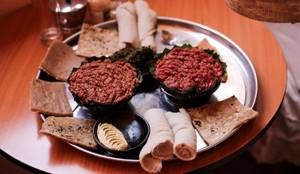
Japanese food
There is no doubt that the healthiest cuisine in the world is Japanese. And it’s not so much about the food itself, but about the food culture itself. The Japanese are accustomed to eating food slowly, in small portions and with colorful vegetables. The country's cuisine includes many green vegetables, including cabbage, negi (green onions) and nasu (eggplant). The Japanese are sincere fans of healthy food, so they choose seasonal products. So, in spring, more bitter vegetables and many spices are used. The Japanese also like light seasonings: wasabi, pickled ginger, soy sauce, miso soup and tsukemono (pickles). Most Japanese drink green or white tea with meals.
Time of intake and amount of food required
Today, most foods can hardly be called healthy food, since the amount of necessary healthy substances is sharply reduced, so I recommend that you think about what healthy food is and take very seriously what you eat.
Along with the quality of the food you eat, it is very important at what time and in what volume you take it, because if you do it incorrectly, your stomach will face oppressive heaviness and painful heartburn, and your body will experience premature fatigue, so let’s find out what time of day and how much need to eat.
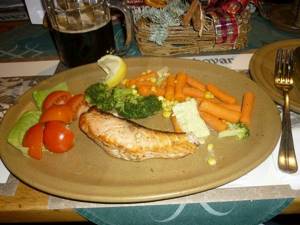
Morning breakfast is the time when the human body just begins to wake up and function weakly, processing morning food, so it should not be particularly dense and contain 1/3 of the daily food intake, and the acceptable meal time for this is from 7 to 8 am .
At this time, the digestion process is not yet so active, so all the food you eat for breakfast should be saturated with slow carbohydrates, which are just beginning to be difficult to digest, and are subsequently quickly and efficiently absorbed.
Lunch time does not have such a strict time frame, so lunch time can be in the range from 12 to 14 hours, right now digestion is at its most active. At this time, you can already eat a hearty and satisfying meal, consuming more proteins, fats and carbohydrates, since all this lunch food will be perfectly absorbed and digested as much as possible without any noticeable heaviness for your stomach.
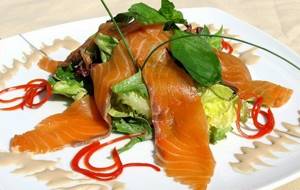
Evening dinner is the time when some feeling of hunger arises, for which the best time to eat may be from 18 to 19 hours.
The small amount of food you take should not consist of too salty and spicy, smoked and fatty foods, but only vegetable fats with proteins and carbohydrates that do not overload the stomach before bed, as your body is already preparing for a night's rest.
You should not overeat in the evening, because food should have time to be digested before you go to bed.
For normal functioning, any body needs to replenish its energy reserves and it is better to do this if you eat the right healthy food recipes for every day. Eat healthy food and then you will definitely be healthy and energetic.
| Buy Semushka sweet mixture of roasted nuts with candied fruits, 250 g in the online store OZON.ru |
The amount of food eaten is considered very important, since systematic undereating or excessive overeating negatively affects the human body as a whole, therefore, how much and how to prepare healthy food is up to you, especially since recipes for healthy food today are so varied that you can find them in the open air There are a huge variety of them on the Internet.
If your stomach is 2/4 filled with food, ¼ water and ¼ air, then the digestion process will be the most maximum and effective, and the first belch will serve as a sign of a full stomach for you, indicating a decrease in air in the stomach, so do not overeat.
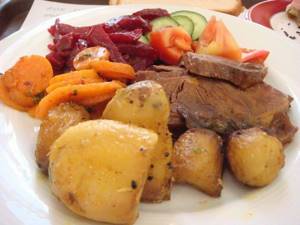
Decide on the amount of food you eat; for breakfast it should be no more than 30%, for lunch - 50%, for dinner 20%, this is the daily amount of food that will allow you to adhere to the correct diet, and your body to work without much effort and unacceptable overload for your health.


